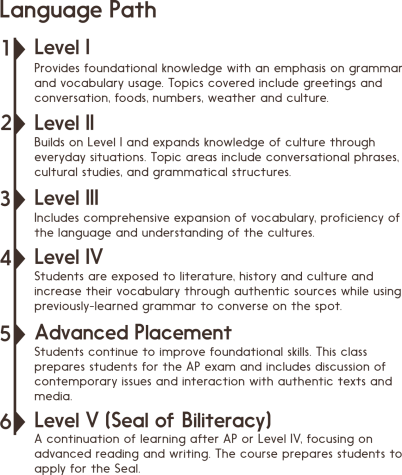Your donation will support the student journalists of West High School. Your contribution will allow us to purchase Scholarship Yearbooks, newsroom equipment and cover our annual website hosting costs.
January 20, 2022
For most high school students across the country, learning a foreign language is a requisite for graduation, college admissions or both. According to a West Side Story survey with 76 responses, more than 90% of West students are learning at least one new language. Currently, the ICCSD offers two languages: Spanish and French.
Helen Orszula ’24 took French I her freshman year. Her experience on Duolingo, a language learning app, was one factor that helped her test into French II for the last trimester of that school year. Only a month into her sophomore year, Orszula transferred from French III to AP French.
“I think my main problem was that we weren’t moving fast enough,” Orszula said.
Similarly, some students noticed a lack of new material being introduced as they progressed through the language curriculum. From conjugations to sentence structure, teachers often review lessons from year to year.
“In the Spanish curriculum, I feel like we have repeated many lessons from eighth grade to ninth grade. We should move not faster, but in a different direction,” said Vinicius Marra ’24.
Others, like Spanish learner Anna Verry ’22, found value in the slower pace in helping to build foundational skills.
“Having that slow pace at the beginning really set us up for success and later classes because we were really focusing on the basics,” Verry said.
Like other classes, some students who were a part of the online program last year struggled to keep up with their workloads in Spanish and French.
“The assignments didn’t feel real so I kind of put them off,” Orzula said. “Being in a classroom with other people really helps me.”
Aidan Ohl ’22 took AP French online last year. Despite getting high grades in the class, he opted out of taking the AP exam.
“There’s a couple exceptions, but really, it just felt like everything was based on writing and prepared speech. I think that’s only really half of being fluent,” Ohl said. “So my grade, despite being good, didn’t actually reflect the fact I didn’t feel great about my skills.”
Verry, who took AP Spanish in person last year, shares a similar sentiment.
“I don’t feel confident enough to go to a native speaker and have a conversation with them,” Verry said. “I feel like if I were talking to other students in my class, I would be able to converse with them because I know we’re on the same playing field.”
So my grade, despite being good, didn’t actually reflect the fact I didn’t feel great about my skills.
— Aidan Ohl '22
Spanish II and AP Spanish teacher Monica Aparicio Ruiz thinks that a focus on speaking, listening and utilizing what students learn in class is key to successful language learning. However, she believes that practicing outside of the classroom is also essential.
“Many times, we only use the language in the classroom and then we don’t take it out with us,” Aparicio Ruiz said. “We need to put more of an effort into practicing outside of school.”
Aparicio Ruiz suggests volunteering in local Spanish-speaking communities as a way to gain exposure to the language. Though she advocates strongly for real-world practice, she points to alternative strategies for developing language skills outside of class.
“One thing I’ve been telling [my students] is that it doesn’t even necessarily have to be practicing with a native speaker,” Aparicio Ruiz said. “There are other ways to practice: reading, reading out loud and watching Netflix. Try to immerse yourself.”
Verry recalls Spanish teacher Jamie Sandhu encouraging her students to get extra outside practice, too.
“Even in Spanish II, Señora Sandhu really harped on finding a good podcast to listen to or going to a radio station that spoke Spanish. The reading and listening was definitely [emphasized]. It was like, ‘You should really do this if you want to be successful,’” Verry said.
Some highly-motivated students continue their studies through either the Seal of Biliteracy program or Post Secondary Enrollment Option classes after taking four years of a language. Students can take Spanish or French V, classes offered by the ICCSD, to obtain the Seal of Biliteracy, which is recognized internationally as the ability to communicate in two languages fluently. Others choose to take PSEO classes at the University of Iowa, where they can simultaneously earn credits for both their high school diploma and college degree.

Nathan Wei ’22 is a Chinese heritage speaker who is currently enrolled in PSEO Japanese. He took the class in hopes that he would learn some of the similarities and differences between Chinese and Japanese.
“I am aware that many [Japanese] words and vocabulary comes from Chinese but I wanted to see the areas that contrasted with Chinese such as hiragana and katakana, along with its grammar and honorific system that Chinese doesn’t share,” Wei said.
Wei took Spanish for four years and noticed the fast pace of PSEO courses in comparison to language classes at West. He says his teacher spends less time teaching simple vocabulary and gives far more tests and quizzes. Wei finds this faster pace more engaging and believes West classes should follow suit.
“Teachers should pace the students and teach things more quickly,” Wei said. “The reason why Spanish was sometimes more mundane was that the vocab and conjugations were taught too slowly and I was given too many class days to learn it.”
